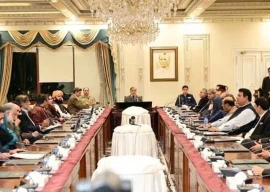
Punjab suffers from high rates of malnutrition as 39% of children are too short for their age, 30% are underweight and 14% suffer from acute malnutrition. Women and children also suffer from some of the world’s highest levels of vitamin and mineral deficiencies, said Planning and Development Department Secretary Arif Anwar Baloch on Monday.
Speaking at the launch of Punjab’s Nutrition Policy Guidance Notes, Baloch said that the alarming malnutrition rates shown by the National Nutrition Survey in 2011 required corrective measures through serious, urgent and collective efforts.
Baloch applauded the Steering Committee on Nutrition, the Technical Working Group and international development partners for helping develop the policy guidance notes.
Farasat Iqbal, the project director of the Punjab Health Sector Reforms Programme, said the nutrition policy notes were developed in consultation with major stakeholders in the public and the private sectors as well as international development partners. He said that there was a global consensus that health sector interventions alone were not enough to address malnutrition, and that a multisector approach including agriculture, education, food, social protection and water and sanitation was required.
Dr Tausif Akhtar Janjua, country director for the Micronutrient Initiative Pakistan, said the main objectives of the dissemination workshop were to seek the feedback of participants and develop consensus on the way forward for the preparation of a nutrition strategy, as well as to strengthen coordination among government departments and development partners to eliminate malnutrition among children and women.

Representatives from the health, food, agriculture, education, social protection and water and sanitation sectors shared their sector-specific policy and proposed action plans to address malnutrition in the Punjab.
Muhammad Javed Malik, a member of the Planning Commission, stressed that the development of the guidance notes on nutrition was the first step towards the goal of eliminating malnutrition.
“There is a long way to go to transform these notes into workable strategies and then develop operational plans for implementing them,” he said. He hoped that Punjab would also take the lead in incorporating the recommendations into work plans for other provinces to follow.
Luc Leviolette, senior nutrition specialist from the World Bank, appreciated the speed with which the guidance notes were developed. He said that now it was time to make strategies and action plans, an accountability framework and build capacity for effective coordination among groups.
He pledged the support of the Pakistan Nutrition Development Partner, a group of 20 donor organisation.
Health Secretary Capt (retired) Arif Nadeem appreciated the input of the participants and urged them to continue their work to address malnutrition.
More than 70 participants from government departments attended the ceremony.
Published in The Express Tribune, February 26th, 2013.
COMMENTS (7)
Comments are moderated and generally will be posted if they are on-topic and not abusive.
For more information, please see our Comments FAQ






















1714494590-0/Pauline-Hanson-(2)1714494590-0-270x192.webp)
1710998259-0/pti-(1)1710998259-0-270x192.webp)







1714370039-0/ojwilson-(1)1714370039-0-270x192.webp)
-(1)1714378140-0/AliAminMaryam-(4)-(1)1714378140-0-270x192.webp)








@Falcon: This is really a very ignorant statement. Money spent on highways, roads and transport systems come from punjab's infrastructure funds.
Furthermore, development of transport routes have been proven to be crucial to the development of cities, and are used as a multi-sector approach to combat poverty the world over.
While clearly not enough is being done to lift the people of Punjab out of the clutches of impoverishment and malnutrition, blaming the construction of roads and transport systems is not a constructive way of doing so.
unfortunately it is mindset of our country that we only admire or appreciate only physical existence of infrastructure rather than human development/Problems...because Infrastructure gets more intention/attraction in media and people.
"Hunger in Punjab: ‘Vitamin deficiencies here among world’s highest". Give the rights of vote to these children and Shahbaz will announce a project soon for them, this is the only solution left in Punjab to get noticed.
Those thousands of Free Laptop can be used for ordering and dispensing vitamins and nutritious foods.
Don' worry, Metro Bus project and the amount spent on advertisement of this will feed the poor when they would travel through this incredible rapid transit system :(
Stunted growth for more than 30% of kids? How is that possible? I thought motorway and metro-bus project have solved all the problems of the province.